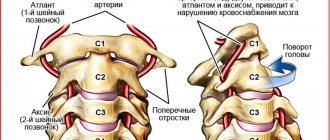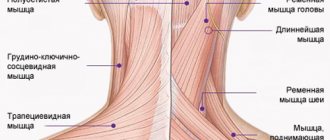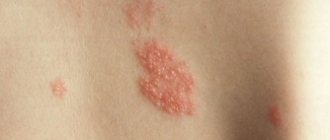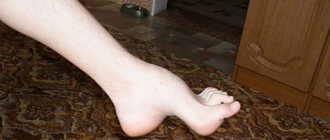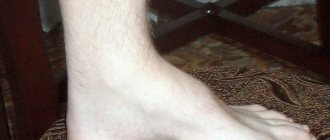Infectious neuritis.
Acute infectious diseases play a large role in the etiology of hearing loss and deafness. Particularly dangerous in this regard is epidemic cerebrospinal meningitis, which often (about 4%) causes complete deafness and, as a result, deaf-muteness. In other infectious diseases (scarlet fever, measles, diphtheria, typhus, relapsing and typhoid fever, mumps), diseases of the inner ear are also not uncommon; they usually lead to varying degrees of hearing loss and, rarely, to deafness.
Diseases of the inner ear and auditory nerve develop: 1) due to the influence of a pathogen on the membranes of the auditory nerve or on the labyrinthine fluid, as is the case with cerebrospinal meningitis, when meningococcus causes purulent labyrinthitis; 2) as a result of penetration of toxins or bacterial decay products into the inner ear, which can occur both through the cerebrospinal fluid and through the vascular system, and through the windows of the labyrinth (with purulent scarlet fever and measles otitis).
Diseases of the inner ear due to syphilis.
Syphilitic lesions of the ear have different localization and distribution depending on the nature of syphilis (acquired, congenital, metasyphilis). Lesions sometimes involve not only the membranous labyrinth, but also the bony labyrinth; sometimes they are localized in the nerve trunk, on its paths and centers; often the lesions are located only in peripheral branches, which are sometimes quickly destroyed due to hemorrhage from the vessel (endarteritis). Diseases of the auditory nerve are observed mainly in neurosyphilis. The most severe forms occur with congenital syphilis.
Based on the symptoms and course of the disease, acquired syphilis can be divided into three forms.
Apoplectiform form. Sudden deafness occurs accompanied by a sharp noise, dizziness and nystagmus. The defeat is permanent. It is most often observed in the second stage of syphilis. The sudden onset of deafness, especially at a young age, should always raise suspicion of syphilis.
O s t r a y f o r m a . Initially, there is subjective noise and slight dizziness with sudden turns of the head, and then rapidly progressive hearing loss.
Chronic form. It is characterized by a slow increase in hearing loss, which usually does not reach a sharp degree.
Treatment of syphilitic lesions is carried out according to the general principles of specific therapy. The effectiveness of treatment depends on how soon after the disease it is started.
Diseases of the inner ear with vascular disorders. With arteriosclerosis and hypertension, degenerative-atrophic changes in the nerve endings in the cochlea and semicircular canals often develop as a result of malnutrition of the inner ear. Clinically, they are characterized by subjective tinnitus, mild dizziness and decreased hearing. Noise and dizziness are especially pronounced in the morning. Hearing loss usually does not reach a severe degree.
In rare cases, sudden deafness occurs with dizziness, vomiting and imbalance. The cause of such acute diseases is bleeding from the vessels of the labyrinth or their thrombosis.
Treatment. General treatment is carried out. It is very important to lower your blood pressure. Bloodletting and leeches provide good results in terms of reducing noise and dizziness.
Symptoms of acoustic neuritis
The main symptom of the disease is hearing loss. Both complete and partial: for example, some patients stop hearing sounds of a certain frequency, perceive the speech of the interlocutor as unintelligible, and note noise or ringing in the ears.
Other symptoms include:
- general weakness,
- temperature increase,
- earache,
- problems with the vestibular system - imbalance, dizziness, nausea or vomiting.
Diagnostics
Diagnosis of acoustic neuritis, as a rule, does not cause significant difficulties and is based on a thorough history, examination and additional examination of the patient. Treatment is conservative and depends on the etiological factors, clinical picture, and nature of the disease. It must be remembered that the success of treatment measures and the prognosis in general depend on the time of initiation of proper treatment. In acute conditions, first aid consists of emergency measures aimed at relieving intoxication, inflammation, vascular disorders, etc. In addition to emergency specific treatment, ENT doctors also carry out complex vitamin therapy, the introduction of neuroprotectors, and symptomatic treatment of the underlying disease that caused the occurrence of auditory neuritis.
Treatment
In acute cases of hearing loss, the patient is indicated for inpatient treatment. In subacute cases, a decision on this issue is made individually; in the chronic form, they almost always begin with outpatient examination and treatment. In acute and subacute cases, they strive to restore hearing to 100%; in chronic cases, this is most often impossible to do, so it is primarily about stabilizing the condition and preventing the progression of symptoms of the disease. Therapeutic tactics are formed, first of all, based on the established cause of the disease.
So, if the culprit is a viral infection, then antiviral drugs are prescribed. If the type of virus is established, then selective therapy is preferable (for example, if the auditory nerve is damaged by the herpes virus, Acyclovir drugs are prescribed). For a bacterial process, antibiotics are indicated. In this case, the use of known ototoxic drugs (aminoglycosides) should be avoided. Typically, high doses must be used to achieve sufficient therapeutic concentrations of the antibiotic.
If the cause of hearing loss is poisoning with any toxic substance, then detoxification therapy is carried out (intravenous drip infusion of solutions of Reopoliglucin, Ringer, physiological sodium chloride solution, and so on).
For traumatic injuries, painkillers and diuretics are indicated (the latter are prescribed to reduce swelling of the auditory nerve). For autoimmune processes, hormonal agents are used.
Drugs that improve blood flow and nerve nutrition are widely used. This is a group of vascular agents and drugs that improve microcirculation (for example, Cavinton (Vinpocetine), Vasobral, Nicergoline (Sermion), Pentoxifylline (Trental)). Mexidol (Neurox, Mexicor), vitamins E and C can be used as antioxidants. Vitamin B complexes (Milgamma, Benfolipen, Neuromultivit and others) have a positive effect.
Sometimes it is possible to use drugs that improve the conduction of impulses along the nerve. These are drugs such as Neuromidin (Amiridin, Ipigrix, Aksamon) and Proserin.
In the treatment of acoustic neuritis, non-drug treatment methods are actively used: electrophoresis with drugs, acupuncture, hyperbaric oxygenation, magnetic therapy.
In cases where the cause of hearing loss is a primary tumor process, surgical treatment is resorted to. This can be a gentle stereotactic operation (using a gamma knife) or a more traumatic craniotomy (when the skull is opened to get to the tumor). If the cause is metastasis of another tumor, then radiation therapy is usually limited.
Complete loss of hearing in one or both ears raises the question of hearing aids for the doctor. This area is quite widely developed at present, allowing us to help people who have not heard for many years.
Diagnosis of auditory neuropathy
- Otoscopy, examination of the ear with instruments using an otoscope
- Pure-tone audiometry
- Acoustic impedance measurement, AR, is a set of diagnostic procedures that are performed to assess the condition of the middle ear
- Recording short-latency evoked potentials (SLEPs) is the brain's response to a sound stimulus recorded from the surface of the head. To do this, the doctor glues small electrodes to the skin in the patient’s forehead and ears.
- Otoacoustic emissions (OAE), this technique uses a small, very sensitive microphone inserted into the outer ear canal to monitor the faint sounds produced by the outer hair cells in response to stimulation
All of the research methods listed above are completely painless and safe, so they can be used for young children, as well as for older children and adults
Your doctor may also prescribe additional research methods for hearing testing.
Treatment of sensorineural hearing loss
To make a diagnosis of sensorineural hearing loss, a specialist must conduct pure tone threshold audiometry - an objective test of the patient's hearing using an audiometer. The person puts on special headphones, and he picks up a special remote control with a button. Sounds of different frequencies and volumes are delivered to each ear of the patient in turn; if the person hears them, he reacts by pressing a button. In this way, an audiogram is formed - a graph reflecting the degree and nature of hearing impairment.
Treatment for sensorineural hearing loss can only be successful in the earliest stages. As we remember, hearing begins to decline due to the fact that the nerve cells of the auditory analyzer are poorly supplied with oxygen. The task of the patient and the specialist is to react in a timely manner before they die. Therefore, treatment will be aimed at improving blood circulation in problem areas. If a person does not receive qualified help on time, sensorineural hearing loss will become irreversible.
Like any disease, sensorineural hearing loss is easier to prevent than to treat: a healthy lifestyle, timely treatment of otitis media and viral diseases, fresh air and careful attention to protection from ambient noise will allow you to keep your hearing healthy.
If the disease has become chronic, there is no need to despair. Yes, the consequences are irreversible, yes, a person will never be able to hear on his own, but today there are technologies that allow a hearing-impaired person not only to return to live communication, but also to preserve residual hearing.
Sensorineural hearing loss, disability
Today in Russia, disability for sensorineural hearing loss is assigned at the 4th degree of reduction. This is the deepest degree, followed only by complete deafness. Children are assigned disabled status at the 3rd degree. Also, those who have chronic sensorineural hearing loss, bilateral, grade 3 or lower, can often count on disability.
Sensorineural hearing loss
All methods of treatment and rehabilitation for sensorineural hearing loss can be divided into medications, physiotherapeutic treatment, hearing aids, auditory exercises and cochlear implantation.
Drug treatment depends on the course and stage of the disease, the period of onset of hearing loss, as well as the etiological factor. Nevertheless, it is possible to identify some features that reflect the impact on various parts of the pathogenesis of the disease. If hearing loss is associated with vascular disorders, which is less common in children than in adults, it is possible to use drugs that improve hemodynamics not only in the inner ear, but also in the vessels of the brain (nicotinic acid, dibazol, no-spa, papaverine). In case of acute sensorineural hearing loss, which has developed as a result of acute intoxication, it is advisable to use mannitol, adenosine triphosphoric acid (ATP) in large doses, magnesium sulfate, as well as dehydration therapy, hyperbaric oxygenation. During the same period, sedatives are used: elenium, trioxazine. Since tissue metabolism suffers to a greater extent in chronic sensorineural hearing loss, FiBS, ATP, aloe extract, vitamins B1 and B6 are used to improve metabolism in the inner ear. Finally, to improve the transmission of nerve impulses in synapses, stimulating drugs (proserin, galantamine), as well as Cerebrolysin, homotoxicological drugs are prescribed.
Of the physiotherapeutic methods, reflexology has recently found quite widespread use (acupuncture, acupuncture, electropuncture, pulsed low-frequency magnetic field in combination with endoaural phonoelectrophoresis of medicinal substances in the inner ear, etc.). Despite the relatively low effectiveness of these methods in improving hearing, their use is justified due to the reduction of such a painful symptom for the patient as tinnitus.
The effectiveness of any treatment largely depends on the period of onset of hearing loss. The disintegration of the axial cylinder and myelin sheath of the auditory nerve begins within the next few days after the onset of hearing loss, and by about 1-1.5 months, reactive inflammatory changes develop in Schwann cells, which play a major role in the trophism of the nerve. The regenerative capabilities of the auditory nerve are very small due to the peculiarities of the blood supply to the cochlea and the lack of collaterals.
All this requires the correct orientation of the pediatrician in the tactics of treating children with acute hearing loss. If such a diagnosis is established, the child is immediately hospitalized in a specialized department. Active detoxification, anti-inflammatory, vasodilator and other therapy (unithiol, suprastin, heparin, nicotinic acid, hyperbaric oxygenation, etc.) within 1 month after the onset of hearing loss allows to restore hearing in almost 80% of cases.
With persistent, long-term sensorineural hearing loss, conservative therapy is practically no help due to the onset of degeneration of the receptor apparatus of the cochlea, and sometimes the auditory nerve.
Hearing aids and deaf pedagogical methods. Hearing aids have recently been widely used in childhood. New hearing aids and sound amplification equipment for classes are being developed, based on the latest technologies. Their significant miniaturization has been achieved, models have been created that are placed in the external auditory canal (intracanal devices). This is of particular importance for children, since many do not want to use the device for aesthetic reasons.
Modern electronic technology makes it possible to produce devices that are free from noise and whistling. Due to these interferences, many children refused to use hearing aids, especially at an early age. The quality of information obtained from hearing tests has improved, and as a result, an individual approach has become possible (ear plugs, computer-assisted selection).
All these circumstances have significantly expanded the capabilities of hardware hearing aids; currently it is used from a much earlier age, from 1.5-2 years. Methods for group teaching of hearing-impaired children have also been improved.
The general scheme for the rehabilitation of hard of hearing and deaf children consists of several stages:
- identification of hearing-impaired children based on mass screening;
- in-depth study of hearing to assess the degree of its loss and determine the localization of damage to the auditory analyzer using auditory evoked potentials, acoustic impedance, reverse acoustic emission of the cochlea, and at a later age (from 3-4 years old) - play audiometry;
- selection of a hearing aid to wear;
- selection of sound amplification equipment for classes with a teacher of the deaf;
- determination of a system of deaf pedagogical classes for the purpose of hearing-speech and general development of a deaf child;
- drug maintenance therapy aimed at stabilizing hearing function.
All this work should be carried out comprehensively with the participation of an otolaryngologist, an audiologist, a pediatrician, a psychoneurologist, a teacher of the deaf, and a specially trained hearing prosthetist.
Computer signal processing technologies, which make it possible to record responses against the background of continuous bioelectrical activity of the brain and determine the frequency and intensity of sound perception in newborns (and even in the fetus starting from the 20th week), are only the basis, a prerequisite for the use of modern capabilities in hearing aids.
One of the main tasks of hearing aids is choosing the optimal operating mode of a hearing aid or adjusting it (excluding the zone of discomfort). The hearing aid must be individualized, since even with similar audiograms, there is no absolutely identical degree of hearing loss. Even a seemingly successfully selected hearing aid is often rejected by a child due to the so-called acoustic feedback, which manifests itself as extraneous noise or whistling sound, especially on the street.
Hearing care for children is more complex than for adults. Unlike adults, whose main goal is to restore the perception of spoken speech as completely as possible, for children the main task (especially at first) is to develop the ability to listen, understand and reproduce speech, i.e. speech training. The critical age for this is 2-3 years.
When using hearing aids for adults, determining the optimal mode of functioning of the hearing aid is possible based on the patient’s subjective response. A small child, naturally, does not give such answers or is confused in his assessment.
, computer analytical systems (CAS) have recently been developed that make it possible to objectify the choice of the optimal mode of operation of a hearing aid, to carry out hearing aids at an earlier age, and to more accurately select the type of hearing aid. CAS also plays an important role in the selection of an individual earmold, which makes it possible to increase the effectiveness of hearing aids by 20-30% and avoid side effects.
Hearing prosthetics is closely related to the work of a teacher of the deaf, whose task is to work with children with hearing impairment and provide advisory and methodological assistance to their parents. In special institutions and sign offices, children undergo a comprehensive comprehensive medical and biological examination, during which the diagnosis is clarified, the possibilities of treatment, hearing aid, education and the profile of a preschool or school institution are determined.
The population of deaf children is very diverse. All children with whom special rehabilitation classes are conducted can be divided into several groups:
- younger and early ages (from birth to 1.5 years);
- early and pre-school age (from 1.5 to 3 years);
- late deafened children (2.5-3 years) - who lost their hearing after mastering speech and retained it;
- children with hearing impairments studying in public schools.
It is especially important to work with late-deafened children and, above all, with those who do not benefit from sound-amplifying equipment. In the first period of onset deafness, their speech in sound, vocabulary and syntax is no different from the speech of hearing children. Nevertheless, such children should be immediately included in the system of education for the deaf. The fact is that the younger the child (2-4 years), the faster speech decay occurs. So, for example, a 2-year-old child stops speaking in phrases just 1 month after the onset of deafness, and after another 1 month he simply stops speaking. In a 3-year-old child, after 4 months, speech becomes insufficiently intelligible, and after six months it disappears altogether. In 4-year-old children, this period can last up to 1 year. If the child is 5-6 years old, complete loss of speech rarely occurs, but it worsens significantly.
The early start of correction of hearing defects, already from 6 months of age, allows one to expand the possibilities of auditory perception, facilitates the formation of oral speech and social adaptation. With persistent and correct training, speech hearing can be developed even in the deaf, since even the deaf and mute have “remnants” of hearing.
In recent years, the method of hearing reduction has become widespread in the practice of working with hard of hearing children , i.e. development of perception based on residual hearing through the use of special auditory exercises. Sounds or individual sentences are transmitted to the child's ear using amplification equipment and combined with the display of television images, pictures and repetition of images. As a result of a long course, pronunciation improves and auditory memory is consolidated.
Cochlear implantation. Despite the successes of hardware hearing aids, a significant proportion of deaf children remain practically without help.
First of all, this applies to patients in whom only a very small part of the cochlear receptor apparatus has been preserved. In these cases, significant amplification of sounds with the help of a hearing aid is required, but pain occurs earlier (narrow dynamic range). This situation prompted researchers to attempt true prosthetics of the non-functioning cochlea and gave rise to a new direction called cochlear implantation.
(cochlear implant) was developed in which complex speech encoding processes take place, based on advances in computer technology. However, it is impossible to remove a non-functioning cochlea and replace it with this prosthesis, so the cochlear implant is left outside, and the thinnest electrodes are surgically inserted into the cochlea, through which a coded signal is transmitted.
The general scheme of cochlear prosthetics looks like this. Sounds (speech) enter a miniature microphone connected to an amplifier and a processor in which they are converted. The signals then enter the transmitter. This part of the prosthesis is external. The second part, internal, consists of a receiver and electrodes (up to 22). The receiver is usually surgically placed in the temporal bone, and electrodes are inserted through the fenestra vestibule into the scala vestibular along its entire length to the apex of the cochlea.
Cochlear implantation operations entered world practice in the late 80s, and from the early 90s they began to be performed on children.
There are a number of motives that force us to use this very complex operation in children. Often a child cannot tolerate a hearing aid due to side effects: noise, dizziness, vibrotactile irritation. Large amplification of sound by a hearing aid can lead to destruction of the organ of Corti. The absence of sound stimulation of the cochlear nuclei in a child for many years causes their atrophy.
The main indications for cochlear implantation are: congenital malformations, ototoxic deafness, hearing loss after viral and infectious diseases complicated by meningitis.
The duration of the onset of deafness is of great importance, since 4-5 years after meningitis, bone obliteration of the scalae of the cochlea occurs and it becomes impossible to insert electrodes into them.
The age of children for surgery does not matter, but the optimal age is about 3 years, when children have a greater potential ability to assimilate new information.
It is very important to determine the degree of hearing loss, the ability to perceive speech even with a hearing aid, but the main thing is the preservation of the structures of the sound-conducting apparatus. If they are also affected, then the indications for cochlear implantation are sharply narrowed.
The operation on the inner ear itself is complex and requires good knowledge of the topography of the cochlea and surrounding structures, and mastery of microsurgery techniques. Operations in children have particularities due to the ongoing growth of the skull and middle ear, purulent otitis media, etc.
After the operation, the work of the teacher of the deaf with the child is very important. It sometimes lasts for months. With a positive result, a completely deaf child, with the help of a cochlear implant and visual assistance (lip reading), distinguishes up to 90-95% of phrasal material.
Thus, cochlear implantation, although it has not yet received widespread practical use, has essentially become the method of choice for children with complete cochlear deafness.
